Tigers in the Park: A New Project in Singapore
The Adam Park Project (TAPP) is a ground breaking battlefield archaeology project looking into the wartime heritage of the Adam Park housing estate in Singapore. It is headed up by the Singapore Heritage Society and the National University of Singapore and partly sponsored by the National Heritage Board of Singapore. The project founder Jon Cooper, alumni of the Centre for Battlefield Archaeology at Glasgow University, is now currently managing the project.
Latest News from the Adam Park Project
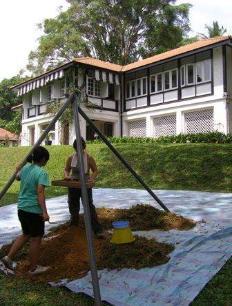 The ‘Big Dig’ at Adam Park
The ‘Big Dig’ at Adam Park
The TAPP Surveys culminated with a three week ‘Big Dig’ in April 2011. Five separate survey teams descended onto the estate in an attempt to recreate the 1942 landscape in which the Cambridgeshires fought their battle and the POWs spent their nine months of captivity. The teams undertook geophysics, aerial photography, topographic and architectural surveys as well as excavations and metal detector surveys over the course of the 21 days on site.
The NUS archaeology team excavated two features in the gardens of Adam Park. The first proved to be nothing more than a flower bed with a fine collection of flower pots as evidence. However the second feature outside No.18 Adam Park turned out to be a trench filled with 1940’s rubbish. This included ammunition boxes, anti gas cream, primer stoves and plenty of tin cans. The most impressive find was a pair of British army boots. There was even a fragment of a Mills grenade – unusually with the pin still in it!! It appears that the post combat occupiers of the house had decided to fill the handy trench with the detritus from the war time occupation. The trench was treasure trove of wartime material and was clear evidence – as if any more was still required - as to the incredible potential of the site.
The concluding metal detector surveys were undertaken during the same period. In total over 1,800 artefacts were uncovered during 10 metal detector surveys that covered over 2,200m2 of gardens. Approximately 38% of the finds were related in some way to the WW2 occupation of the estate including over 470 cartridges and bullets. The patterning of ordnance across the site revealed more about the intensity and type of fighting that took place around the estate and the smattering of individual items such as regimental badges, gravemarkers, buttons and webbing accessories superbly personalised the story.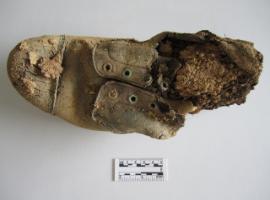 The teams are now away preparing the final reports and mulling over the results of the surveys. The summer will be spent bringing these together into a final project publication.
The teams are now away preparing the final reports and mulling over the results of the surveys. The summer will be spent bringing these together into a final project publication.
2012 marks the 70th Anniversary of the fall of Singapore and the TAPP team hope this incredible collection of artefacts and the exhaustive research will be the centrepiece of the commemorations.
Read Jon Cooper's latest contribution to Britain at War magazine which follows on from his November 2010 article:
Britain at War, February 2011:
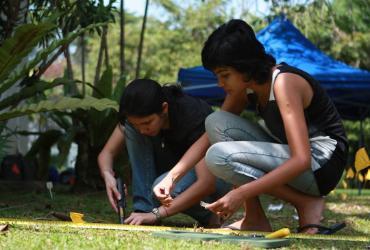 New Year Surveys are Underway at Adam Park
New Year Surveys are Underway at Adam Park
February beckoned in the Chinese year of the Rabbit and it was marked by a flurry of activity around the Adam Park Estate. The Centre has continued working with The Adam Park Project team in delivering the latest round of surveys and research initiatives.
Thanks to the many local sponsors and the NHB, enough funds have been raised to begin a number of new surveys on site. The project architects, led by Dr Yeo Kang Shua, have been looking for traces of the POW Chapel mural using infra- red photography to scan the chapel walls. NUS Archaeologists, under the watchful eye of Lim Chen Sian, have been undertaking trials with their new aerial photography rig and carried out the first stages of the topographic survey in their attempt to recreate the 1942 battlefield landscape.
The latest metal detector survey in front of No. 8 Adam Park revealed the greatest concentration of ordnance to date. Over 140 cartridges and 90 bullets have been unearthed in a 50m square area along with numerous pieces of webbing equipment and uniform accoutrements, all thought to have been dumped out of the house after the fighting.
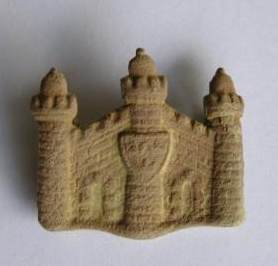 However the most evocative find was a collar badge from the Cambridgeshire regiment - pictured here. If one metal item could sum up the work being done at Adam Park then perhaps this would be it. It’s the first irrefutable link between the site and the regiment.
However the most evocative find was a collar badge from the Cambridgeshire regiment - pictured here. If one metal item could sum up the work being done at Adam Park then perhaps this would be it. It’s the first irrefutable link between the site and the regiment.
The project manager, Jon Cooper (Mlitt class of 2008) hosted a press tour of the project site during the second week of the surveys. ‘The national media response has been excellent and it’s great to see the surveys underway after months of research and raising sponsorship. We still need more funds though and we will continue to raise the project profile, not only here in Singapore but also back in the UK and Australia’.
More surveys are planned for March and April including excavations of features thought to be slit trenches found in the front gardens of the houses
Jon added ‘This site continues to reveal incredible finds and amazing stories – I’m sure we will be unearthing some great stuff in the spring’.
WW2 Burnt Horde in Singapore Reveals Tragic Fate of Hospital
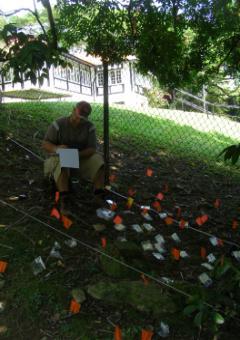 When young Tom Burridge called to say that he had found a couple of bullets in the front garden of No.17 Adam Park little did the TAPP team know they were in for an incredible discovery. Tom had diligently noted the location of his finds and was able to take us straight to the site. To our amazement, especially as we had surveyed the other end of the garden months earlier, we found the ground scattered with bullets, cartridges and other WW2 artefacts. The lawn was literally covered in items and there were more to be seen on the other side of the fence at 8 Adam Park.
When young Tom Burridge called to say that he had found a couple of bullets in the front garden of No.17 Adam Park little did the TAPP team know they were in for an incredible discovery. Tom had diligently noted the location of his finds and was able to take us straight to the site. To our amazement, especially as we had surveyed the other end of the garden months earlier, we found the ground scattered with bullets, cartridges and other WW2 artefacts. The lawn was literally covered in items and there were more to be seen on the other side of the fence at 8 Adam Park.
There followed a hectic two weeks of surveys in which we recovered over 120 bullets and cartridges as well as what appears to be a full set of British Type 37 webbing including an entrenching tool, bayonet and water bottle. But what was most interesting was the amount of molten glass that scattered the site and some of the military items such as a binoculars’ base plate had clear signs of burning. This was conclusive evidence supporting the written history that No.17, which had housed the Cambridgeshires Regimental Aid Post, had indeed been burnt down. The equipment seemed to have been dumped under the hedge out of site during the clear up of the site, presumably by the POWs and forgotten about.
This incredible site has inspired sponsors to come forward and finance the next round of surveys to take place in February 2011. Let’s hope we find much more of the same.
Britain at War Magazine Publication November 2010
Footscray Coves and the Singapore Police
The metal detector surveys at Adam Park have resumed after the holiday break with a detailed look into the front garden of 18 Adam Park.
This house was occupied by the ‘4 Platoon - Carriers’ led by Capt JRE Stagg and Lt FW Munday throughout the 14th and 15th February 1942 where they repelled a number of Japanese attacks and held the line under severe bombardment.
The house was used by Australian POWs throughout 1942 and was later restored on behest of the Japanese at a princely sum of $4991sg before being rented out at $140 a month to high ranking Japanese officials and army officers.
The survey once again revealed a plethora of fascinating artefacts including over 30 bullets and cartridges of various calibres including Webley pistol and Thompson SMG bullets. As predicted the majority of the Japanese bullets were found around features believed to be the remains of the platoon’s slit trenches.
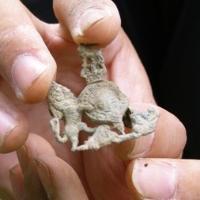
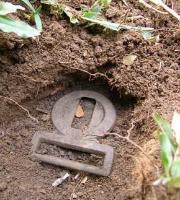 The most impressive finds were the discovery of a Straits Settlement Police belt buckle and a General Service cap badge or WO1 wrist badge. Both items were found in close proximity to each other very near the house along with other belt accoutrements. The research is now focused on identifying the owner of the buckle and working out why these items had been discarded.
The most impressive finds were the discovery of a Straits Settlement Police belt buckle and a General Service cap badge or WO1 wrist badge. Both items were found in close proximity to each other very near the house along with other belt accoutrements. The research is now focused on identifying the owner of the buckle and working out why these items had been discarded.
One of the more unusual stories associated with 18 Adam Park is the remarkable story of two Digger POWs who were buried in the garden. Both men died within a day of each other in May 1942 and were buried side by side in the camp cemetery. Both were Australians, one a navy stoker, the other an army driver and when the bodies were moved up to Kranji War Cemetery after the war and were reburied just two rows apart. However what is more remarkable is that both men originate from Footscray in Victoria and grew up a few kilometres from each other. We ran an article in the local paper on the story and we are now in contact with the next of kin of one of the men. I am sure this story will continue on.
Odol and Nambus - The Adam Park RAP Reveals a Violent Past
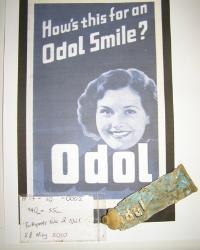
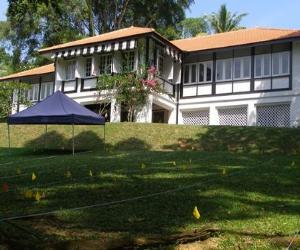 Two weeks of metal detecting at No.17 Adam Park has clearly demonstrated the potential of the Adam Park site for wartime archaeology. No.17 is believed to be the location of the Regimental Aid Post during the occupation by the Cambridgeshire Regiment. It was set alight on the 15th February as the ceasefire broke down and tank shells once again tore into the house. The ruins were later sold by the enterprising POWs to a local Chinese trader and they stripped everything that was worth anything in order to supplement their meagre wage.
Two weeks of metal detecting at No.17 Adam Park has clearly demonstrated the potential of the Adam Park site for wartime archaeology. No.17 is believed to be the location of the Regimental Aid Post during the occupation by the Cambridgeshire Regiment. It was set alight on the 15th February as the ceasefire broke down and tank shells once again tore into the house. The ruins were later sold by the enterprising POWs to a local Chinese trader and they stripped everything that was worth anything in order to supplement their meagre wage.
Today the property is the beautiful home to the Scott family who kindly invited us in to survey their front garden which despite the coming and goings of swimming pools and gazebos has remained remarkably intact. The evidence of the fighting is still clearly visible in the landscape. A number of uniform depressions were evident and these were thought to be a series of three man gun pits dug by the Cambridgeshires. This theory was born out of the discovery of 25 Japanese bullets of which some appeared to be from bursts of machine gun fire that targeted the trenches. Further excavations of these features will be needed to prove for certain their role in the fighting.
Other individual finds included a tube of 1940’s Odol toothpaste made in Norwich and the remains of what appears to be a Japanese pistol – possibly hidden by the POWs for later use.
The site was also visited by Mr Inoue and Mr Sogabe , the regimental historians for the 41st Regiment from Fukuyama, the unit that had fought against the Cambridgeshires for Adam Park. They were thrilled by the discoveries and grateful that the team was giving equal consideration to the Japanese side of the story.
Jon Cooper, the project manager, added ‘We were also pleased to welcome local students from the university and film crews from Channel News Asia onto the site – it’s a great privilege to share this story and show Singaporeans what we are unearthing.’
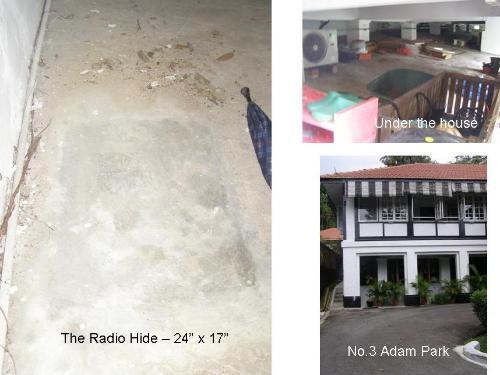
Research continues in Adam Park as the team expand their scope to reveal the history of the POW camp that was set up on the estate in March 1942. Latest interviews with Australian Imperial Force veterans in Australia have led to the discovery of a hide for a camp radio. Radios were banned by the Japanese; any POWs found with one were likely to be shot or beaten, so a good hide was essential. This particular 12 valve set, capable of listening into the BBC broadcasts from New Delhi, was hidden in a compartment dug into the concrete under one of the houses at Adam Park. An old ice box with a false bottom was then placed over the top and filled with books. Lloyd Ellerman, the keeper of this particular set, reckons they never missed a midnight broadcast from the BBC and the Japanese certainly never discovered the set. He had to abandon it when they were moved to Sime Road - who found it and filled in the hole is not known.This is one among several incredible finds being unearthed at Adam Park. The research team are also on the trail of the POW's chapel, theatre and canteen. In the meantime the project managers are in the process of raising funds and obtaining permits for future work.
If you feel you can contribute in any way with this fascinating project please contact:
Jon Cooper
TAPP Project Manager
jonalicooper@googlemail.com
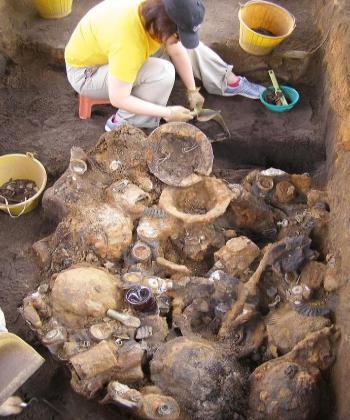 WWII archaeology found intact during Padang dig, Singapore
WWII archaeology found intact during Padang dig, Singapore
As if proof was needed that WW2 archaeology of high quality is to be found in Singapore the National University of Singapore Archaeology Team, led by Lim Chen Sian from the Department of South East Asian Studies, recently uncovered an old ARP trench. The discovery came while they were digging for 14th / 15th Century pottery on the Padang; the historic ceremonial area opposite the City Hall and Supreme Court, in the very heart of the city.
Jon Cooper, the TAPP Project Manager, and the Centre’s man in Singapore, was called in to help excavate the artefacts found within the trench on Christmas Eve. He said of the discovery:
'It’s a stroke of luck that the ARP trench just happened to be in line of the series of excavation pits laid out by the team looking for traces of pre-colonial Singapore . It appears that the trench was turned into a rubbish pit by civil servants within the City Hall at the time of the surrender to the Japanese in 1942. For the most part, the artefacts consist of Mk V Respirators and steel helmets thrown into the pit, presumably after the ceasefire. All the respirators are date stamped either1940 or 1941. The rubber masks look to be in pristine condition when first exposed but disintegrate to the touch. Judging by the presence of numerous buckles and remnants of canvas straps, the respirators were discarded inside their bags. You can just imagine a line of disgruntled civvies and the servicemen parading past the pit, throwing this stuff in. Empty wine bottles may be a legacy of those final moments as people tried to dull the impact of what was unfolding around them - it’s an incredibly vivid reminder of the surrender. And to think that three and a half years later Mountbatten marched past not more than 20yds away to take the Japanese surrender!'
There was however no time or resource to get to the bottom of the pit and the intention is to cover up the site, earmark the location for protection and return to excavate it fully at a later date. There is of course great speculation as to what may be found at the bottom of the trench; perhaps items that were not meant to be found by the Japanese!
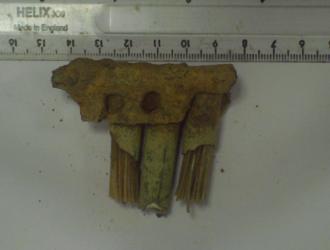 First Survey of the Adam Park Survey highlights archaeological potential
First Survey of the Adam Park Survey highlights archaeological potential
The Adam Park Project has issued the first draft of the Research Document. This is to be used as a guide for archaeologists planning the next phase of surveys. The document has been well received by various cultural agencies in Singapore. Work has now started on tracking down veterans and next of kin both in the UK and Japan.
Recently a preliminary metal detector survey was carried out at No.20 Adam Park to clear an area of garden destined to become a new veranda. The exercise proved very successful, with military buttons, coins and bullets recovered. The most striking find was a clip of .303 ammunition from a British Lee Enfield rifle (see photo). Jon Cooper, the project leader, said ‘The fact that this was a dropped clip may give some idea of the intensity of fighting in this part of estate. The man who lost this clip didn’t have time to reclaim it, suggesting the area was not safe to hang around in. It’s a great start to the surveys.'
The Adam Park Project Profile
Work has commenced on the Centre’s latest project* - this time out in the Far East. Jon Cooper, after successfully gaining his MLitt in 2008, has started up the research phase of a year long project looking at the potential for battlefield archaeology in Singapore.
As the demand for more housing and new development slowly covers the island in concrete, the need to preserve and rescue vital WW2 battlefield heritage has never been more urgent. Up until now much of the limited resource has been focused on preserving the concrete fortifications which have for many years represented all that was bad about the 1942 invasion and the British defeat. However many of these sites were bypassed by the Japanese or abandoned by the British and witnessed little of the actual fighting.
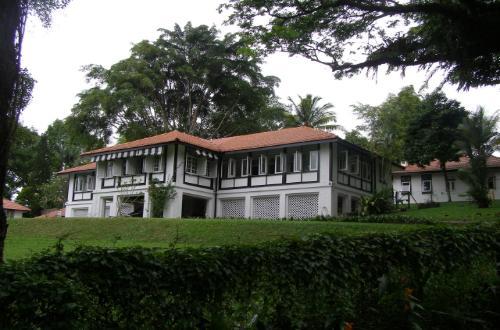 This project is unique for the island as it focuses entirely on the battlegrounds and is attempting to evaluate the potential for the recovery of artefacts lost during the actual fighting. The case study for the assessment is the defence of the Adam Park Estate by the 1st Battalion of the Cambridgeshires Regiment, ‘The Fen Tigers’, from the 12th to 15th February 1942.
This project is unique for the island as it focuses entirely on the battlegrounds and is attempting to evaluate the potential for the recovery of artefacts lost during the actual fighting. The case study for the assessment is the defence of the Adam Park Estate by the 1st Battalion of the Cambridgeshires Regiment, ‘The Fen Tigers’, from the 12th to 15th February 1942.
As Jon says, ‘This is an incredible story relating to the fighting at such a seminal point in the campaign. Here was a TA unit, originally destined to fight in the Middle East, finding itself in Singapore, only to be told it was all over and they were never going to win. Not only do the Cambridgeshires decide to fight, but they are the only unit who stand their ground during the Japanese onslaught. They take and hold positions in a housing estate at Adam Park, fighting for three days without water and minimal rations, under constant air attack and artillery barrage, inflicting hundreds of casualties and destroying numerous Japanese tanks. Finally, on the 15th, they are cut off and surrounded and their commander requests permission to break out. In response, he receives news of the general ceasefire that presages the surrender. Many of his men remain unaware of the ceasefire and fight on beyond the deadline as they were totally cut off from their HQ.’
‘The survivors of the Cambridgeshires are then herded into a tennis court for three days before starting their long march to Changi and 3 ½ years of captivity from which many never return. It’s a gut wrenching finale to an epic piece of military history.’
Adam Park today lies on the edge of city’s expansion and the distinctive black and white bungalows receive government protection and date back to the fighting.
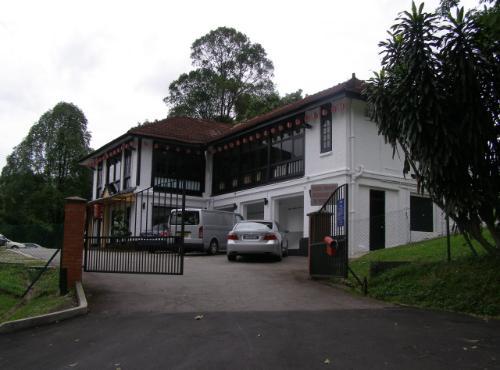 ‘Its amazing to think that these houses, verandas and gardens were the ones that the Cambridgeshires established their positions in. Some were even occupied by the Japanese then recaptured by the British. The Battalion HQ at No.7 Adam Park is now home to a Japanese Restaurant, how ironic is that! We also hope to find the Tennis Court used as a holding pen after the engagement, it’s such a poignant part of the landscape. ’
‘Its amazing to think that these houses, verandas and gardens were the ones that the Cambridgeshires established their positions in. Some were even occupied by the Japanese then recaptured by the British. The Battalion HQ at No.7 Adam Park is now home to a Japanese Restaurant, how ironic is that! We also hope to find the Tennis Court used as a holding pen after the engagement, it’s such a poignant part of the landscape. ’
The project team hope to construct a detailed plan of the estate as it was when the British took it over and identify the location of their field works. It will then be possible to work out why the Park was so difficult to take.
‘If we can figure out why the defence of Adam Park was so successful it may be possible to theorise about what would have happened had the British fallen back into similar positions all around the city and fought to the last man as Churchill had requested. This was the type of fighting Yamashita was afraid his men would get involved in. With the Imperial army’s supplies stretched and the troops so tired, could the British have held out for longer in such enclaves?’
On a more practical level the project also hopes to identify the pitfalls and problems of working on WW2 sites in a tropical urban environment and hopes to stimulate enough interest to kick start further work on other sites, especially at Pasir Panjang, site of the last stand of the Malayan Regiments and Kranji shoreline where the Australians successfully repelled Japanese landings.
The Project Team have already been in contact with the IWM at Duxford, home of the Cambridgshire’s Regimental Museum and hope to contact veterans of the fighting in order to obtain eyewitness accounts that may help their research.
Watch this site for the latest news as the project develops.
*Note: The project was formally passed from handed over to the Project Partners in July 2010

